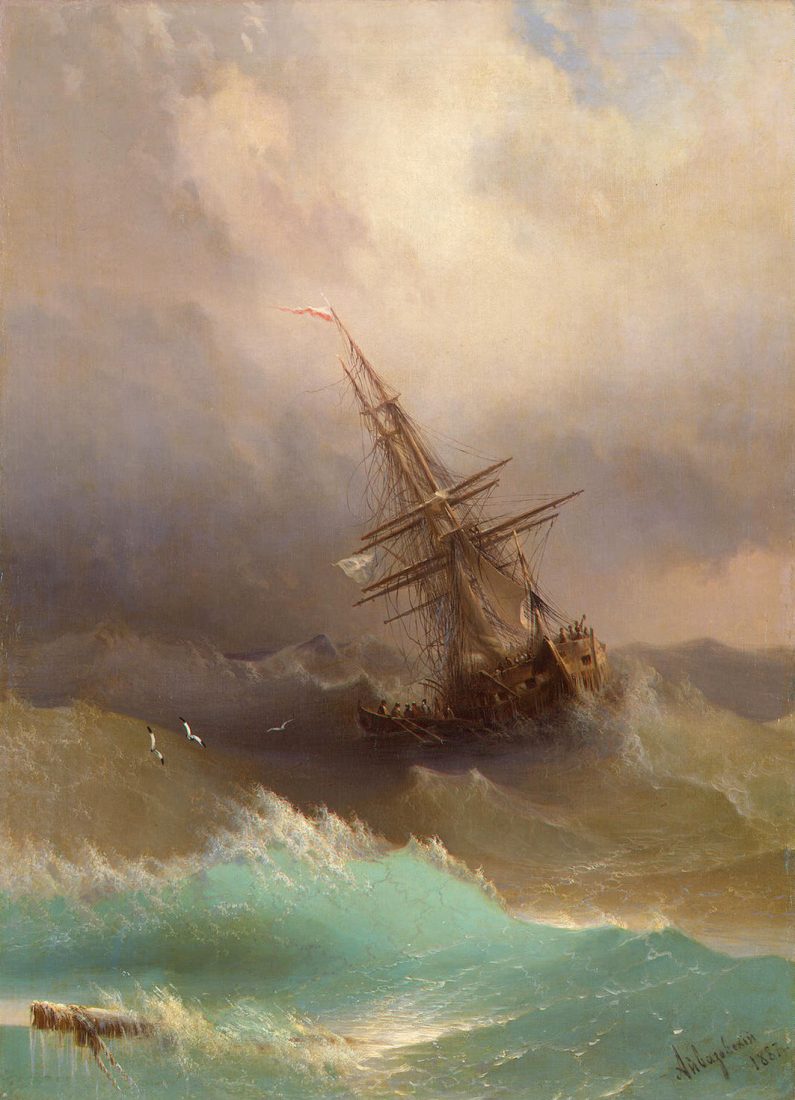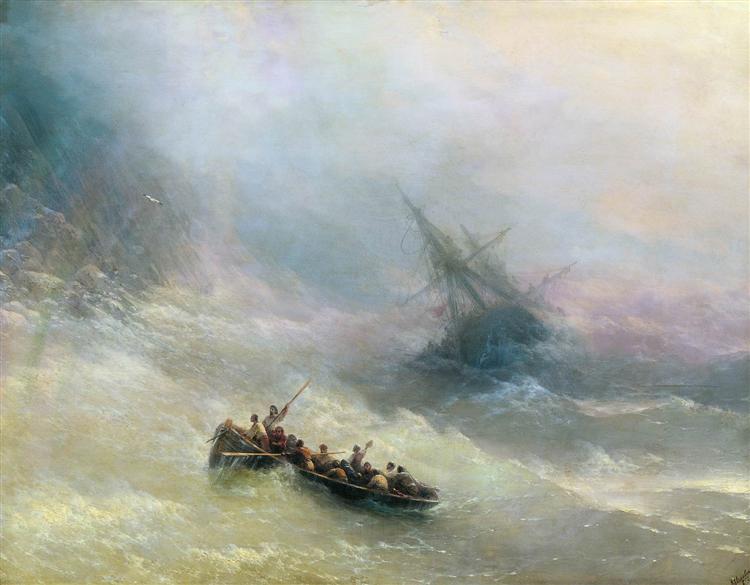How HMS Flora died hard: 1808
Another article on this blog, “HMS Flora 1780: the Carronade’s arrival”(click here to read it), dealt with a spectacular action in which this 36-gun frigate was engaged shortly after her first commissioning. The present article is however more melancholy, since it tells how this fine ship met her end over a quarter-century later. The manner of her wrecking is illustrative of just how strong such ships were and how much battering they could endure before finally succumbing. HMS Flora’s demise was slow and nightmarish but the efforts of her crew to save her were all but superhuman.
The image that immediately comes to mind of the Royal Navy’s years-long blockades in the Revolutionary and Napoleonic Wars is of the squadrons stationed off Brittany and Toulon. No less important, and as dangerous as duty off Brittany, was blockading of North Sea coasts. That of the Netherlands, a staunch and committed vassal of France for much of the period, was especially dangerous in view of the shallow waters and shifting sandbanks. It was when patrolling close to the Friesian Islands north of the Netherlands mainland, that HMS Flora, then under the command of Captain Loftus Otway Bland (1771 – 1810), ran aground on 18th January 1808 off the island of Terschelling.

HMS Clyde – a frigate generally similar to HMS Flora. She’s seen here escaping from the Nore anchorage at the time of the great mutiny in 1797. She was one of only two ships on which the captains could maintain order
It was past high water when HMS Flora struck. Bland, an experienced and well-regarded officer, recognised that there was no hope of getting her off until the next tide. He accordingly directed all weight to be removed from aloft, for the topmasts to taken down and jettisoned and for the hull to be shored up internally. The wind strengthened to a gale by late afternoon, bringing with it a heavy swell. Efforts to lighten continued – water supplies were dumped as well as most of the shot and other heavy items on board. All hands took their turn at the pumps but the hull had been breached and water level continued to rise. By nine o’clock, as high water approached, the hull began to heave, but increasing wind resulted in dragging of the anchors that had been let out and driving the ship further on to the sand. A last effort of letting go an anchor proved successful and brought her head around. With sail set, the wind now drove HMS Flora across the shoal and into deeper water.

“A Ship in a Stormy Sea off a Coast” by the great Russian marine artist Ivan Konstantinovich Aivazovsky (1817 – 1900). If seen from shore, HMS Flora’s plight would have looked very similar.

Aivazovsky conveys well here the horror of a ship aground
Though now floating, serious damage had been sustained. The rudder had been carried away, and with it the launch and the jolly-boat, so that only one anchor and a single boat remained. Already exhausted men continued to pump and a sail was passed under the ship’s keel in a vain attempt to stop the water ingress. Bland was later to praise the discipline of his crew at this extremity, but the water level internally was still rising. With the rudderless HMS Flora held bow-on to the waves by a single anchor, Captain Bland took the hard decision that his only hope of saving his crew was to wear ship (i.e. turn the stern towards the wind), and run her on to Dutch shore. This was a dangerous – and irreversible – action as it would mean letting go the last anchor. Before doing so, lightening efforts continued, the guns now being thrown overboard. The final decision was taken at half-six the following morning, when the sky had brightened. The cable was cut, sails used to bring the head around and a sea anchor trailed astern. Steering by sails alone, HMS Flora headed for the nearest island.
The weather was worsening and shortly before ten o’clock HMS Flora was brushing ground again. Captain Bland ordered the main and mizzen masts to be cut away. Only the foremast now stood, with sail set, to drive the ship over the next shoals. At this stage further grounding was perhaps a lesser evil, preferable to being carried seawards again with an ebbing tide which would surely involve the damaged vessel sinking. HMS Flora’s plight was now visible from shore. While operating in this area previously, Bland had never taken action against local fishing boats, and had indeed purchased fish from them. Several were now in the vicinity but they made no attempt to assist.
HMS Flora drifted on. She grounded finally and irretrievably at four o’clock in the afternoon. Surrounded now with breakers, and with no answers to her distress signals, there was nothing to be done but to abandon ship. All hands that could be spared from the pumps had set making rafts, and these were now launched into the surf. Some hundred and thirty of the crew got up on them and managed to reach shore. Captain Bland, with a few officers and men, took to the only boat left. Initially intent perhaps on escape rather than surrender, they rowed for eighteen hours without any sustenance, until at last, wholly exhausted they landed on the island of Ameland, where they were captured by the Dutch authorities.

Though depicting a different wreck, Aivazovsky (1817 – 1900) gives an idea of the danger faced by Bland’s boat when it left HMS Flora
Some of the crew – eighty or ninety to a hundred perhaps, given that HMS Flora’s complement would have been about 250 – had elected to remain on board the ship. They survived there for four more days and nights and, except for nine who apparently died of exposure, they finally reached shore safely.
For Captain Bland the aftermath was bitter and tragic. He was imprisoned in damp conditions and this brought on “consumption” – tuberculosis – or accelerated it if he had already been infected. He was returned to Britain in a prisoner exchange and, as was usual when a captain had lost his ship, faced court-martial. He was acquitted and his efforts to save her had been so well appreciated that he was immediately promoted to command of a 64-gun third-rate, HMS Africa. Her duties took her to the Baltic and here the cold and damp were to worsen Bland’s health still further and force him on sick leave. He was to die in 1810, just two years after his epic attempts to save HMS Flora and her crew. He was only thirty-nine, yet another of the officers whose careers were cut short too soon and who never attained the senior ranks they deserved.
Do you read naval fiction?
You will enjoy Britannia’s Gamble
1884 – fanatical rebels, the ISIS of their day, are sweeping all before them in the vast wastes of the Sudan and establishing a rule of persecution and terror. Only the city of Khartoum holds out, its defence masterminded by a British national hero, General Charles Gordon. His position is weakening by the day and a relief force, crawling up the River Nile from Egypt, may not reach him in time to avert disaster.
But there is one other way of reaching Gordon…
A boyhood memory leaves the ambitious Royal Navy officer Nicholas Dawlish no option but to attempt it. The obstacles are daunting – barren mountains and parched deserts, tribal rivalries and merciless enemies – and this even before reaching the river that is key to the mission. Dawlish knows that every mile will be contested and that the siege at Khartoum is quickly moving towards its bloody climax.
Outnumbered and isolated, with only ingenuity, courage and fierce allies to sustain them, with safety in Egypt far beyond the Nile’s raging cataracts, Dawlish and his mixed force face brutal conflict on land and water as the Sudan descends into ever-worsening savagery.
And for Dawlish himself, one unexpected and tragic event will change his life forever.
Britannia’s Gamble is a desperate one. The stakes are high, the odds heavily loaded against success. Has Dawlish accepted a mission that can only end in failure – and worse?
Below are the ten Dawlish Chronicles novels published to date, shown in chronological order. All can be read as “stand-alones”. Click on the banner for more information on each book. All are available in Paperback or Kindle format and can read at no extra charge by Kindle Unlimited or Kindle Prime Subscribers.
Six free short-stories are available for download to your Kindle. Access them by registering for the Dawlish Chronicles mailing list – just click on the banner below. You’ll be kept updated on new books and will receive other free stories at intervals.




